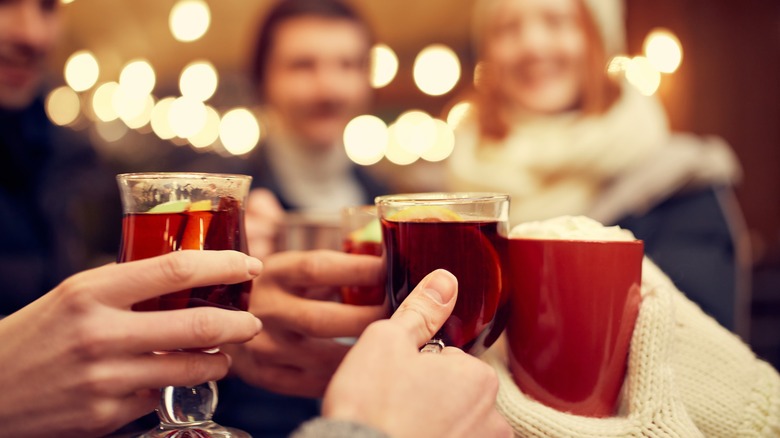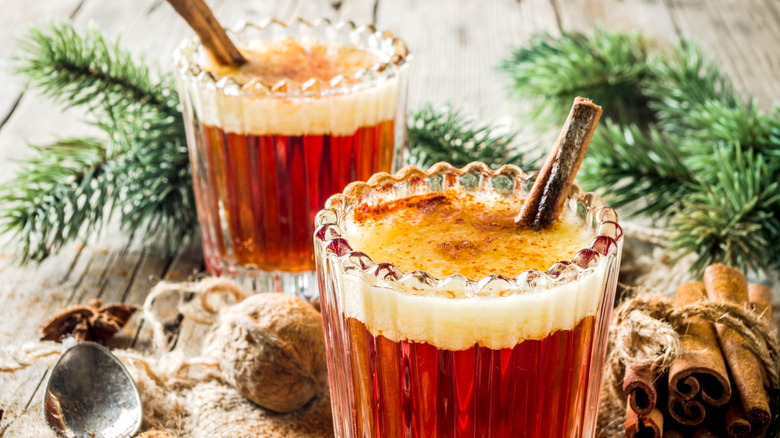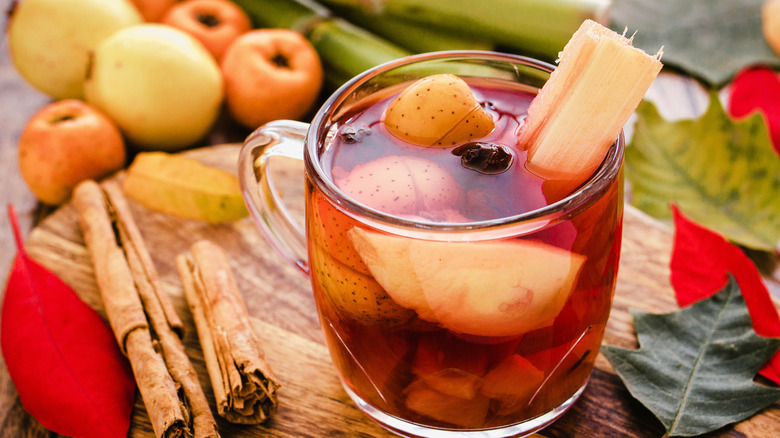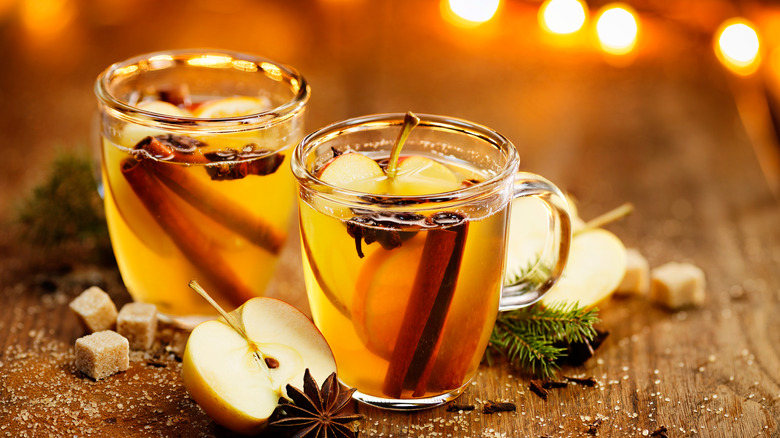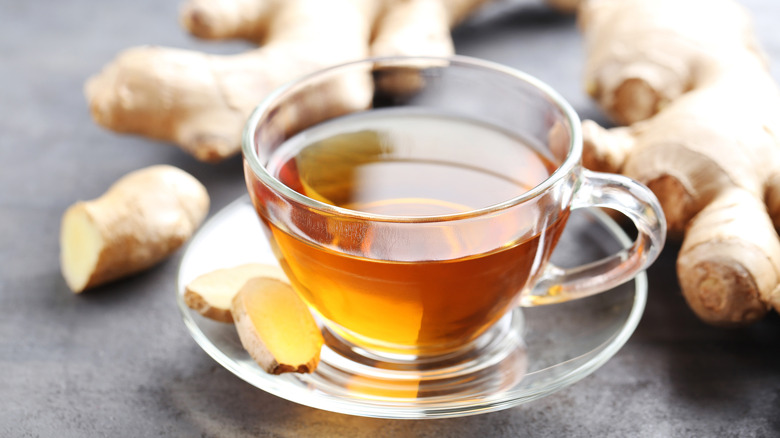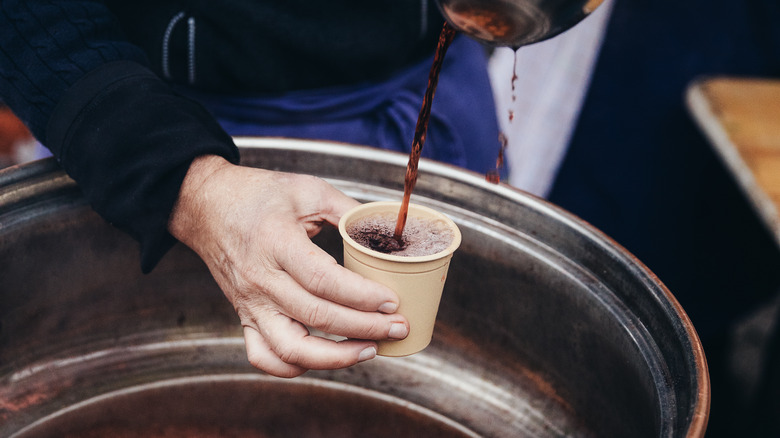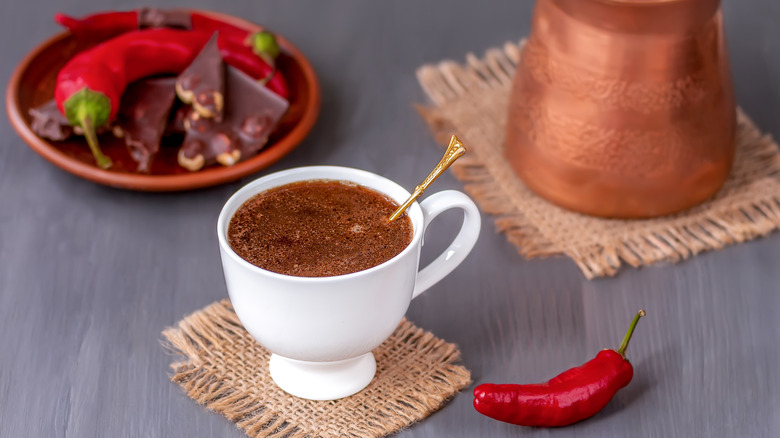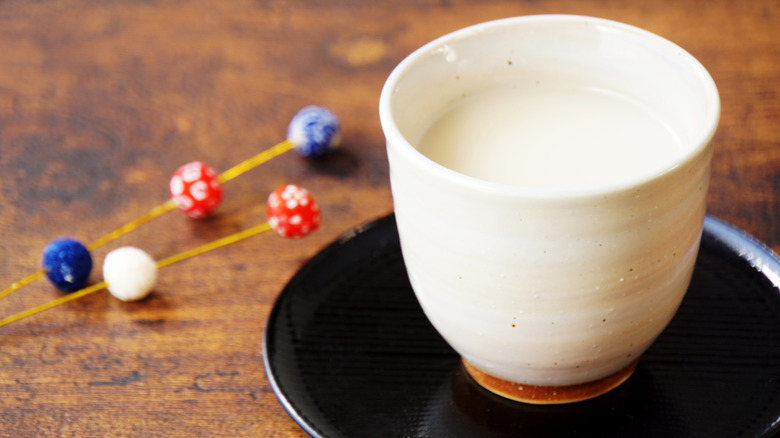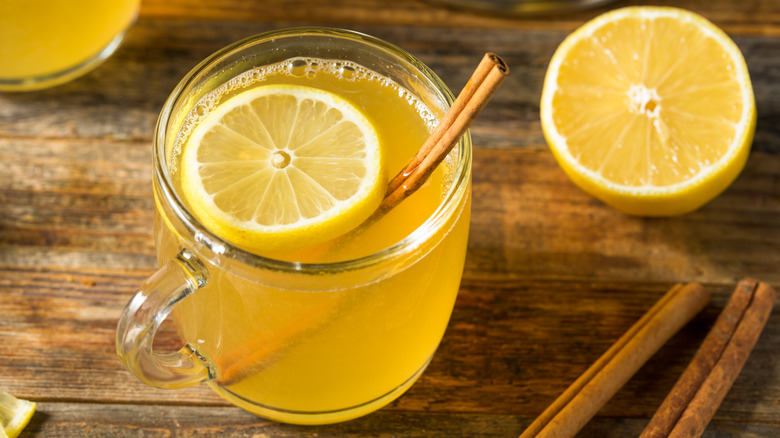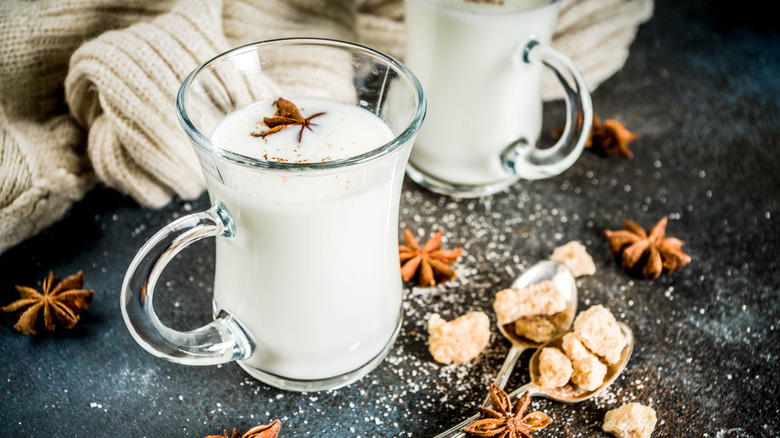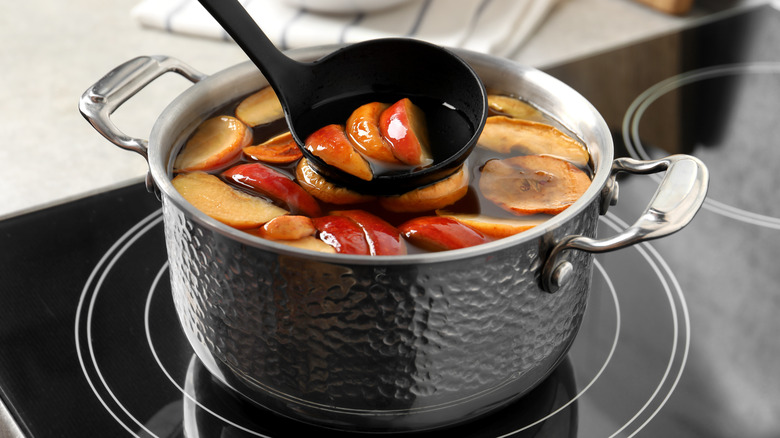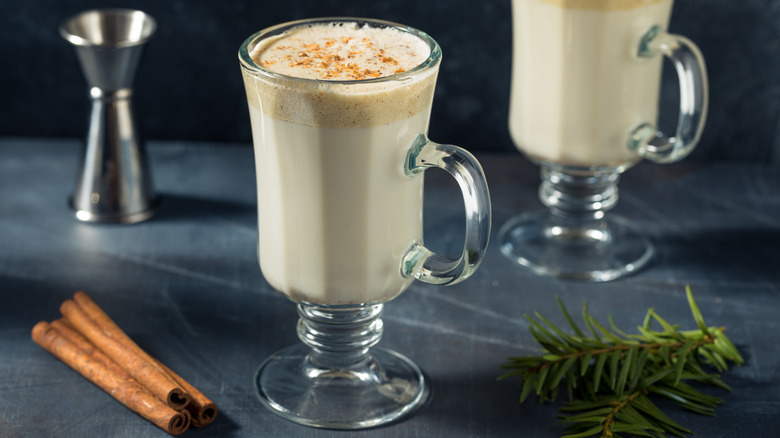The Best Hot Drinks To Enjoy During The Holidays
On a cold and icy winter evening, there are few things more soothing than being warm and snug indoors with a nice hot drink. This kind of comfort is central to the Danish art of hygge, and it's been a tradition across human cultures for thousands of years. Mixology notes that hot drinks were originally shared by groups of people, and drinking hot wine during the colder seasons dates back to Ancient Roman times. Warm beverages, both with and without alcohol, have been enjoyed ever since, and there's a wide variety of winter drinks from around the world to help stave off the cold.
A hot mug of some festive beverage can certainly help to warm you up, but many drinks give an extra boost in calories too. This is by design. As Vox explains, cold weather really does make your body burn more calories to stay warm, which is why many classic seasonal drinks, like eggnog, are so hearty. Enjoyed all across North America during the holiday season, eggnog's origins date back to medieval Europe. It was originally made with ingredients associated with the wealthy, like figs and sherry, as well as eggs and milk. But if you find yourself getting tired of it during the holidays, there are several delicious alternatives worth trying.
Hot buttered rum
Calorific and warming, hot buttered rum is a classic American winter drink. The Daily Gazette explains that hot buttered rum dates back to before the American Revolution, and was once an essential part of celebrations during the festive season. Its high-calorie content has made it less popular in recent years but, before modern heating and insulation, it would have been a great way to keep warm over winter. Rum was once a favorite alcoholic beverage among Americans, and it was commonly believed that a hot alcoholic drink was the fastest way to warm up after spending time outdoors in frosty weather.
At its heart, this drink is a mixture of dark rum and spices, sweetened with brown sugar and with a dollop of butter stirred in for good measure. One obvious question, however, is why people decided to include butter in their rum. The reasoning behind this is lost to time, but one hint comes from another hot drink from the other side of the world. In Tibet, a favorite drink is po cha, better known as butter tea. According to Brooklyn Tea, this is exactly what it sounds like -– tea made with butter — and the butter helps prevent chapped lips in the dry, cold Himalayan weather. It's quite possible butter was originally added to hot rum for much the same reason. Whatever the reality was, hot buttered rum is a warming winter drink and also a taste of an old American tradition.
Ponche Navideño
Every year, families across Mexico gather for Christmas celebrations, and no Mexican Christmas is complete without a steaming cup of ponche navideño. EHL Insights mentions that the name literally translates as "Christmas punch," and it's essentially a Mexican version of mulled wine. On Christmas Eve, it's customary for households across the country to keep a pot of ponche navideño hot on the stove, permeating the air with a warm, spicy aroma.
Ponche navideño is made with a variety of fruits, both fresh and dried, including sour tamarind and wholesome prunes, as well as any number of seasonal fruits like guavas, oranges, and tejocotes. It also includes hibiscus flowers, sugar cane, and cinnamon, and is sweetened with piloncillo, a type of unrefined sugar that is used in all kinds of Latin American cooking.
For those who prefer their drinks alcohol-free, the booze is optional in ponche navideño. It can be a delicious beverage to enjoy, even for those who need to drive home later. Just like the rest of Mexican cuisine, the exact recipe for ponche navideño varies from place to place, so you can spend less time worrying about getting it exactly right, and more time enjoying this delicious seasonal beverage.
Mulled cider
Filled with the crisp, sweet flavor of apples, mulled cider is a lighter and more refreshing version of its famous cousin, mulled wine. Both drinks, however, have a long and proud history. The Republic of Tea explains how it all centers around mulling spices. Sweet and aromatic, these are easy to recognize, and usually include cinnamon, cloves, and allspice among other ingredients.
Using them in hot beverages reportedly dates back to the Roman Empire, almost 2,000 years ago, and while the Romans were particularly fond of mulled wine, people around Europe began to make other mulled drinks too. Around the Middle Ages, mulled cider became widely popular in England and Germany, brewed with a mixture of cinnamon, nutmeg, and ginger. It was also sweetened and, at the time, honey would've been the most readily available kind of sugar.
Mulled cider is still a festive favorite in many places, and it's usually quite easy to pick up a glass of it from European Christmas markets to enjoy while shopping. Outside the U.S., all ciders are hard ciders, so the drink normally contains alcohol for an extra kick, per Atlas Obscura. The sharp apple flavor, however, is the most important part, so a non-alcoholic mulled cider made from apple juice is no less enjoyable.
Ginger tea
Ginger tea isn't technically considered a holiday drink, but it's warming and healthy so it more than earns its place on this list. A light drink with the slow burn of spicy ginger, this is a soothing beverage to enjoy after a hearty meal or while relaxing late at night. Ginger tea has an even longer history than some of the other drinks on this list, having been enjoyed in China for around 5,000 years, according to the BBC. It wouldn't be until much later that ginger would reach European kitchens, where it was no less prized.
Ginger tea is easy to make. While Chinese grocery stores frequently sell it pre-made, the simplest preparation method is to take either fresh or dried ginger and infuse it in hot water for a few minutes.
Ginger is also widely regarded to be good for your health! In particular, a cup of ginger tea is an excellent digestive aid. Natural compounds in ginger can reduce nausea and encourage your digestive system to get moving, meaning ginger tea can be helpful for anyone with an upset stomach. Even if your stomach is perfectly fine though, it can still be an excellent beverage to enjoy after a heavy holiday dinner.
Glühwein
Mulled wines are easily one of the most famous festive drinks, enjoyed all across Europe. There are plenty of regional variations, but perhaps the best known of all is German glühwein. Germany is well-known for turning their Christmas celebrations up to 11, so much so that it's not uncommon to find a German Christmas market in cities all across Europe. Needless to say, these markets always include at least one stall selling glühwein which, as The Culture Trip explains, translates to mean "glow wine." The name is reportedly a leftover from a centuries-old tradition in which the wine was heated with a glowing red hot iron.
Glühwein also sits very conveniently alongside a few of 2022's drink trends. Per EHL Insights, boxed wines have become popular recently for being more sustainable and easier to store at home. A box of red wine is also the perfect start for a steaming hot pan of mulled wine. The spices used also play nicely with current trends, with cloves being a common ingredient in glühwein and also having been recently praised for their health benefits. It can even be made with non-alcoholic wine or red grape juice, meaning that nearly anyone can enjoy a soothing mug of hot glühwein over the festive season.
Chili hot chocolate
Chocolate has been a dietary staple in Mesoamerica since long, long before Europeans arrived there. According to History.com, it was the Ancient Olmecs who first enjoyed chocolate as a beverage some 3,500 years ago. Their knowledge was later passed on to the Maya people who enjoyed thick and wholesome chocolate drinks. Mexico Lore notes that the Maya have long enjoyed drinks like "honey cacao," "chili cacao," and "foamy cacao," and chocolate has always been an important part of Maya culture.
While milk is a more modern addition to the brew, chili and chocolate is a time-honored combination and one that is blissfully warming in cold weather. For a delicious twist on Mayan hot chocolate, add some ancho chiles and sweet honey to a cup of wholesome hot chocolate and top it with almond slivers for a deliciously soothing drink. It's particularly nice to enjoy on a cold winter night.
Amazake
During the New Year, temples across Japan serve cups of smooth, sweet amazake. Rich and flavorsome, it's a traditional Japanese hot beverage made from fermented rice. Its origins date back to Japan's Kofun period over a millennium-and-a-half ago, and it's been praised as a healthy winter drink ever since. Fermented drinks have recently seen a revival in popularity in western countries for their health benefits, making amazake an attractive drink to try. It's created in a similar way to sake, known in Japan as nihonshu, the famous Japanese rice wine. The name amazake literally translates as "sweet sake" but don't let this fool you. This drink is not alcoholic.
Per Timeout, amazake is readily available at winter festivals in Japan, where it's usually served in paper cups. It has a sweet taste with the wholesome fragrance of rice, and is often served with a little grated ginger stirred in. While it may not be available at any festivals outside Japan, pre-made amazake can be easily bought from online vendors and some East Asian supermarkets. Alternatively, starter cultures are also available, and it's quite easy to ferment a batch at home. A steaming hot pan of amazake can make for a light and interesting alternative to the mulled wine and egg nog usually enjoyed over the festive season.
Hot toddy
Strongly alcoholic but a lot lighter than some other seasonal drinks, a hot toddy can make for a refreshing beverage at the end of a cold night. The sharp taste of whiskey is complemented nicely by the tang of lemon juice and offset by the sweet flavors of cinnamon and honey. Quick to make but still slightly indulgent, hot toddies are a favorite seasonal beverage in many households, with the exact ingredients varying according to taste. The drink itself, however, dates back to the 15th century.
The name, as VinePair explains, derives from a Hindi word, "taddy." It was originally a hot drink made in India from palm wine with added spices. The idea, like so many other things, was appropriated by the colonial British and found its way back to England. In the cold winter weather of Britain, whiskey with hot water and spices became a popular beverage, and it later developed into the hot toddy known today. It was even praised as a medicinal drink in the past and was considered a cure for the common cold.
A flexible drink, hot toddies have also been made with brandy and rum, so it's easy enough to substitute your preferred alcoholic spirit when making one at home. Other variations include switching out the lemon for other fruits like cranberry or grapefruit. A hot toddy is perfect for an evening indoors while ignoring the icy weather outside. Better not drink too many though — they can be quite potent.
Anijsmelk
The idea of winter in the Netherlands calls forth idyllic scenes with snowy landscapes, woolen hats with ear flaps, and ice skating on frozen canals. One thing that fits snugly into this picture is anijsmelk, a warming beverage that's perfect for those who want to warm up after an afternoon on the ice. Centuries ago, as Enchanted Living Magazine explains, street vendors in the Netherlands would set up stalls to give people a reprieve from the bitter winter winds and serve this sweet aromatic drink to people taking a break from skating. Still as popular as ever, the Dutch drink anijsmelk offers a subtle spiced flavor and smooth creamy texture.
A non-alcoholic winter warmer, Lonely Planet describes this as an infusion of earthy-tasting star anise in piping hot milk, sweetened with a little sugar or honey. Often served to children, a steaming mug of anijsmelk gives a taste of old-fashioned Dutch homeliness, making for a great way to relax on a cold winter afternoon.
Uzvar kompot
A Ukrainian specialty, uzvar kompot is a fruity winter punch with variations of it enjoyed across the Slavic countries of Eastern Europe. According to Smithsonian Magazine, the sweet brew is made by boiling dried fruit, filled with both the color and the flavor of the fruits involved. That flavor also varies from place to place, depending on what fruits the cook decides to include, and how much sugar they use. Per Discover Ukraine, uzvar kompot is a national Ukrainian beverage that can contain all kinds of fruity ingredients, such as dried apples, pears, and plums, as well as fresh strawberries and blueberries. Spices like anise and cinnamon are sometimes added too. For the fullest flavor, it's best to sweeten this wintery punch not with sugar but with honey.
It's traditional to serve uzvar kompot cold, but it's perfectly fine to enjoy it hot as well. Firmly linked with the festive season, this flavorsome beverage is an essential part of Christmas celebrations in some countries. In Poland, the local version of kompot is an essential part of a traditional Christmas Eve dinner.
Tom & Jerry
For many Americans, particularly in the Midwest, a Tom & Jerry is a firm favorite hot drink during the festive season. As rich and wholesome as egg nog, the usual way to prepare Tom & Jerrys is to pre-make a batch of batter from beaten eggs and spices. This is then kept in the fridge and used as and when needed, served with hot water, rum or brandy, and a pinch of grated nutmeg. Interestingly though, while it's a distinctly American drink in modern times, the inventor of the Tom & Jerry wasn't actually American himself.
Atlas Obscura tells the story of how this beverage's inventor was reportedly a 19th-century British writer. A journalist by the name of Pierce Egan created the beverage as a publicity stunt in 1821. His intent was to create a signature cocktail to market his new book, so he invented a hot cocktail by varying the recipe of egg nog with the addition of brandy. Some consider this story apocryphal, however, and there's a chance it could simply be a myth. All the same, Egan's writing was the source of the phrase "Tom and Jerrying," which once referred to bawdy inebriated merriment. It's uncertain when the drink arrived in the U.S. or how it became such an essential part of a midwestern Christmas, but it's still an excellent way to fight off the cold during the holiday season.
